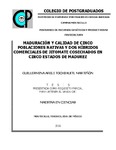| dc.description.abstract | Las poblaciones nativas de jitomate (Lycopersicon esculentum) ofrecen un potencial no cuantificado en características de interés agronómico, calidad y valor nutracéutico por lo cual en el presente trabajo se evaluaron los cambios asociados con el proceso de maduración y calidad del fruto de jitomate tipo saladette y tipo bola de cinco poblaciones nativas (16, BR y R provenientes de Puebla, así como 35 y 38 de Guerrero) y de dos híbridos comerciales (SUN 7705© y Daniela©) , cosechados en cinco estados de madurez (verde maduro, rompiente, rosa, rojo firme, rojo suave), respecto a la vida de anaquel, cambios en el contenido de sólidos solubles totales, % de ácido cítrico, índice de madurez, vitamina C y color. Se usó un diseño experimental de bloques generalizado con cuatro repeticiones, realizando análisis de varianza y prueba de Tukey (α=0.05). La vida de anaquel de la población nativa tipo Saladette es menor que la del híbrido comercial SUN 7705, el color de los frutos es similar, los frutos del híbrido presentan mayor concentración de vitamina C y más alta relación %SST/%ácido cítrico, dándole un sabor más aceptable. En frutos tipo bola, el hibrido comercial Daniela cosechado en estado verde maduro y rompiente no evoluciona a los siguientes estados de madurez, mientras que las poblaciones nativas maduran de manera normal, sobresaliendo la población BR, sin embargo, su concentración de vitamina C es menor, así como su sabor y tonalidad roja menos homogénea. La población 35 presenta una relación %SST/%ácido cítrico similar al híbrido Daniela por tanto su sabor es similar. Todas las poblaciones nativas presentan mayor contenido de ácido cítrico lo que las hace atractivas para su utilización con fines de procesamiento. _______________ MATURATION AND QUALITY OF FIVE NATIVE POPULATIONS AND TWO COMMERCIAL JITOMATE HYBRIDS HARVESTED IN FIVE STATES OF MATURITY. ABSTRACT: The native populations of tomatoe (Lycopersicon esculentum) offer unquantified potential in characteristics of agronomic interest, quality and nutraceutical value for which in the present work the changes associated with the maturation process and quality of tomato type saladette and ball type of five native populations (16, BR y R from Puebla, as well as 35 y 38 from Guerrero) as well as two commercial hybrids (SUN 7705 © and Daniela ©), harvested in five maturity stages (ripe green, breakwater, pink, firm red, soft red); regarding shelf life, Changes in the content of total soluble solids, % Citric acid, maturity index, vitamin C and color. A generalized experimental block design was used with four replicates, performing analysis of variance and Tukey's test (α = 0.05). The shelf life of the Saladette native population is lower than that of the commercial hybrid SUN 7705, the color of the fruits is similar, the fruits of the hybrid present higher concentration of vitamin C and most highest relation % SST /% citric acid, giving it a more acceptable flavor. In ball type fruits, the commercial hybrid Daniela harvested in state green ripe and breaking does not evolve to the following states of maturity, while native populations mature normally, standing out the population BR, nevertheless, Its vitamin C concentration is lower, as well as its flavor and less homogeneous red tonality. Population 35 has a relationship % SST /% citric acid similar to the Daniela hybrid so its taste is similar. All native populations have a higher content of citric acid which makes them attractive for use for processing purposes. | es_MX |


